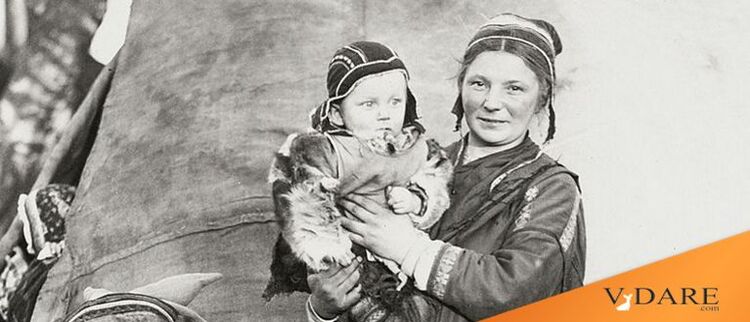


12/26/2023
From The New York Times:
When the Tax Agency Won’t Let You Deduct Your Reindeer-Herding Dog
Indigenous Sami tradition v. Swedish bureaucracy — who wins this dogfight?
By Maria Fredriksson
Ms. Fredriksson is a documentary filmmaker.
I learned about Ida-Maria Svonni’s struggle against Sweden’s tax agency while researching a film about my late grandmother. Like my grandmother, Ms. Svonni is Sami, an Indigenous people who reside in Sweden, Norway, Finland and Russia.
So this mini-documentary is about this blonde Swedish lady’s struggle with Sweden’s hard-nosed tax office to take a tax deduction on the price she paid for a dog. She says that as a Sami (aka, Saami or Laplander) of course she needs to buy a dog to herd her reindeer herd. The tax people say she hasn’t even proved she owns a reindeer herd. She accuses them of cultural insensitivity.
It’s a pretty dull documentary, but I was struck by The New York Times’ insistence that the Sami are an Indigenous (with a capital I) people.
Lots of people these days appear to assume that Swedes must be white settler-colonialists who hitched a ride with Columbus in 1492 and stole Stockholm from the Indigenous people of Sweden. The Swedes do land acknowledgements in Malmo, right?
Surely, the Sami, who are related by language and genetic ancestry to the Finns (Laplanders were called Finns in Norway until fairly recently), are no more indigenous than the other long-time inhabitants of northwestern European countries, and probably have been there a slightly shorter time than the Norse. And their infusion of a minority of Siberian genes is fairly recent in their history.
What the Times seems to mean by Indigenous is not wholly white, but then so are their cousins the Finns, plus the Huns. Others seem to argue that “indigenous” means not-having-your-own-nation-state, but then the Catalans have been indigenous to Barcelona for a long time without currently having Catalonia to rule.
You could reasonably say that the Sami are indigenous (with a small i) to the inland extreme north of northwestern European countries, just as you could say the HiScots are indigenous to the north of Albion. But the NYT doesn’t call Scots indigenous.
And the NYT seems to increasingly use Indigenous with a capital I to mean what used to be fashionably known around 1960 as the Amerindian race, to whom Laplanders are only extremely distantly related.
From Wikipedia:
The speakers of Finnic and Sámi languages have their roots in the middle and upper Volga region in the Corded Ware culture. These groups presumably started to move to the northwest from the homeland of the early Uralic peoples in the second and third quarters of the 2nd millennium BC. … The groups of these peoples that ended up in the Finnish Lakeland from 1600 to 1500 BC later “became” the Sámi. The Sámi people arrived in their current homeland some time after the beginning of the Common Era [i.e., A.D.]
… The Sámi language first developed on the southern side of Lake Onega and Lake Ladoga and spread from there. When the speakers of this language extended to the area of modern-day Finland, they encountered groups of peoples who spoke a number of smaller ancient languages (Paleo-Laplandic languages), which later became extinct.
So somebody was in Finland before them.
… From the Bronze Age, the Sámi occupied the area along the coast of Finnmark and the Kola Peninsula. This coincides with the arrival of the Siberian genome to Estonia and Finland, which may correspond with the introduction of the Finno-Ugric languages in the region.
Petroglyphs and archeological findings such as settlements, dating from about 10,000 BC can be found in Lapland and Finnmark, although these have not been demonstrated to be related to the Sámi people. …
The Sámi have a complex relationship with the Scandinavians (known as Norse people in the medieval era), the dominant peoples of Scandinavia, who speak Scandinavian languages and who founded and thus dominated the kingdoms of Norway and Sweden in which most Sámi people live. While the Sámi have lived in Fennoscandia for around 3,500 years, Sámi settlement of Scandinavia does not predate Norse/Scandinavian settlement of Scandinavia, as sometimes popularly assumed. The migration of Germanic-speaking peoples to Southern Scandinavia happened independently and separate from the later Sámi migrations into the northern regions. …
For centuries, the Sámi and the Scandinavians had relatively little contact; the Sámi primarily lived in the inland of northern Fennoscandia, while Scandinavians lived in southern Scandinavia and gradually colonised the Norwegian coast; from the 18th and especially the 19th century, the governments of Norway and Sweden started to assert sovereignty more aggressively in the north, and targeted the Sámi with Scandinavization policies aimed at forced assimilation from the 19th century.
To Canadians this sounds like what happened to their Indigenous.
But of course, forced assimilation happened to vast numbers of Europeans as well, and is still going on in Eastern Europe (e.g., the government of Ukraine just changed the official date to celebrate Christmas from January 6 to December 25). For instance, Provençal is one of the most important languages in the literary history of Europe: 800 years ago it was the language of troubadours. But it has largely been replaced by Parisian French through the power of the French state.
When Evelyn Waugh visited Norway in 1949, he reported that Norway’s biggest problem was that it didn’t yet have a national language. I don’t know much about Norway, but I presume they’ve dealt with that problem since then.